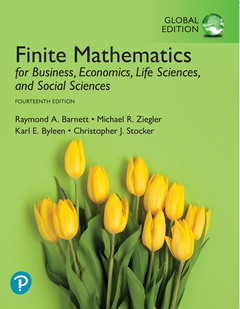Description
Finite Mathematics for Business, Economics, Life Sciences, and Social Sciences, Global Edition (14th Ed.)
Authors: Barnett Raymond, Ziegler Michael, Byleen Karl, Stocker Christopher
Language: English
Subject for Finite Mathematics for Business, Economics, Life...:
92.37 €
In Print (Delivery period: 14 days).
Add to cart716 p. · 21.6x27.4 cm · Paperback
Description
/li>Contents
/li>Comment
/li>
Finite Mathematics for Business, Economics, Life Sciences, and Social Sciences, 14th Edition offers more built-in guidance than any other text for this course ? with special emphasis on applications and prerequisite skills ? and a host of student-friendly features to help students catch up or learn on their own.
I. A LIBRARY OF ELEMENTARY FUNCTIONS
1. Functions and Graphs
1.1 Functions
1.2 Elementary Functions: Graphs and Transformations
1.3 Quadratic Functions
1.4 Polynomial and Rational Functions
1.5 Exponential Functions
1.6 Logarithmic Functions
Chapter 1 Summary and Review
Review Exercises
II. FINITE MATHEMATICS
2. Mathematics of Finance
2.1 Simple Interest
2.2 Compound and Continuous Compound Interest
2.3 Future Value of an Annuity; Sinking Funds
2.4 Present Value of an Annuity; Amortization
Chapter 2 Summary and Review
Review Exercises
3. Systems of Linear Equations; Matrices
3.1 Review: Systems of Linear Equations in Two Variables
3.2 Systems of Linear Equations and Augmented Matrices
3.3 Gauss—Jordan Elimination
3.4 Matrices: Basic Operations
3.5 Inverse of a Square Matrix
3.6 Matrix Equations and Systems of Linear Equations
3.7 Leontief Input—Output Analysis
Chapter 3 Summary and Review
Review Exercises
4. Linear Inequalities and Linear Programming
4.1 Linear Inequalities in Two Variables
4.2 Systems of Linear Inequalities in Two Variables
4.3 Linear Programming in Two Dimensions: A Geometric Approach
Chapter 4 Summary and Review
Review Exercises
5. Linear Programming: The Simplex Method
5.1 The Table Method: An Introduction to the Simplex Method
5.2 The Simplex Method: Maximization with Problem Constraints of the Form ≤
5.3 The Dual Problem: Minimization with Problem Constraints of the Form ≥
5.4 Maximization and Minimization with Mixed Problem Constraints
Chapter 5 Summary and Review
Review Exercises
6. Logic, Sets, and Counting
6.1 Logic
6.2 Sets
6.3 Basic Counting Principles
6.4 Permutations and Combinations
Chapter 6 Summary and Review
Review Exercises
7. Probability
7.1 Sample Spaces, Events, and Probability
7.2 Union, Intersection, and Complement of Events; Odds
7.3 Conditional Probability, Intersection, and Independence
7.4 Bayes’ Formula
7.5 Random Variable, Probability Distribution, and Expected Value
Chapter 7 Summary and Review
Review Exercises
8. Markov Chains
8.1 Properties of Markov Chains
8.2 Regular Markov Chains
8.3 Absorbing Markov Chains
Chapter 8 Summary and Review
Review Exercises
9. Data Description and Probability Distributions
9.1 Graphing Data
9.2 Measures of Central Tendency
9.3 Measures of Dispersion
9.4 Bernoulli Trials and Binomial Distributions
9.5 Normal Distributions
Chapter 9 Summary and Review
Review Exercises
10. Games and Decisions (online)
10.1 Strictly Determined Games
10.2 Mixed-Strategy Games
10.3 Linear Programming and 2 x 2 Games: A Geometric Approach
10.4 Linear Programming and m x n Games: Simplex Method and the Dual Problem
Chapter 10 Summary and Review
Review Exercises
Appendix A: Linear Equations and Graphs
A.1 Linear Equations and Inequalities
A.2 Graphs and Lines
A.3 Linear Regression
Appendix B: Basic Algebra Review
B.1
This title is a Pearson Global Edition. The Editorial team at Pearson has worked closely with educators around the world to include content which is especially relevant to students outside the United States.
Helps students “get the idea” through an extensive built-in guidance
· More than 300 completely worked examples introduce concepts and demonstrate problem-solving techniques.
· Matched Problems accompany each of the worked examples to help students gain solid knowledge of the basic topics and assess their own level of understanding before moving on.
· In order to emphasize problem solving, concepts, and computational skills, most derivations and proofs are omitted, except where their inclusion adds significant insight into a particular concept.
· NEW! Full-color design and modern look helps students navigate the text and enhances its pedagogical features. The revised design is free of potentially distracting elements. The figures in the text have been re-rendered using the latest software and re-conceived to take advantage of a full color palette in order to maximize their instructional potential.
A flexible structure that helps instructors meet the varied needs of their students
· The variety of exercise types and difficulty levels enable instructors to easily craft homework assignments tailored to their students’ needs:
· Exercise sets at the end of each section consist of Skills Warm-up problems that review prerequisite knowledge specific to that section, followed by problems that are categorized according to level of difficulty (A, B, and C), followed by Applications.
o Applications give students substantial experience in modeling and solving real-world problems. Almost every exercise set contains application problems that were derived from real-world situations.
· Chapter Reviews

